Mallorca is undisputedly the epicenter for deep water soloing, i.e. rope-free climbing over the water. In this article you will find all the information and valuable tips you need for a successful DWS stay on the Balearic Mediterranean island.
People have been climbing on the steep cliffs of Mallorca since the early 1970s. This received a lot of attention Deep Water Soloing but only with the film Psicobloc by Josh Lowell in the early noughties. Since then, the enthusiasm for this form of climbing has continued unabated and people from all over the world travel to Mallorca for deep water soloing. You can find out here what it takes for a DWS trip and what you should pay attention to the first time.
You will learn that in this article
- What are the most important tips for deep water soloing for the first time?
- What equipment do you need for deep water solo climbing?
- What safety precautions should be taken?
- How do I reach the start of the routes?
- What makes Mallorca the ultimate deep water soloing spot?
- Where are the different climbing spots?
- Which areas are suitable for getting started with deep water soloing?
- Where do hard movers find difficult DWS lines?
- What are the four best spots on the island?
- These are the 10 most beautiful routes on the island
- The most important climbing guides for deep water solo climbing
What are the most important tips for deep water soloing for the first time?
If you're trying out deep water soloing for the first time, you should take it slow. Here are some tips:
- On the first day, head for an “easy” area such as Cala Varques.
- Before climbing, do a few jumps off rocks and cliffs to get used to falling and being submerged in water.
- Practice getting out of the water. With sore forearms and a bit of swell, the simplest rope climb can feel much harder than expected.
- Choose easy routes and slowly increase the difficulty.
- If you are unsure about the downclimb: consult a climbing guide or ask climbers with more experience who are present.
Deep water soloing with climbing school
If you don't dare to take the first DWS steps alone, you can work with the climbing coaches from Kletterwelt.ch competent partners. Whether in Mallorca or Menorca: thanks to the experience of the Kletterwelt crew, all participants get their money's worth and find exciting projects that challenge them and don't overwhelm them. This makes the Deep Water Solo Trip an unforgettable experience.
DWS beginners will find many routes in easy grades, especially in Menorca.
Fabio Lupo, climbing world
What equipment do you need for deep water soloing?
climbing shoes
As with climbing, in Mallorca you (almost) can't avoid wearing climbing shoes unless you have developed extremely hard calluses over the years and can therefore cope with the often razor-sharp rock on the exits.
It is advisable to take at least two pairs of climbing sparkles with you on a DWS trip so that you can dry them alternately.
Leatherfinches without additional feeding dry faster. It's worth not bringing the latest shoes. Despite regular care during the trip and subsequent cleaning, the salt water leaves its (scented) traces.
magnesium Beutel
When it comes to magnesium bags, it's also worth having several copies with you. A good option is to cut out the inner lining of an older model. The bag dries much faster and can also be rubbed briefly with a towel.
A magnesium bag without a lining dries faster and can be rubbed out with a cloth.
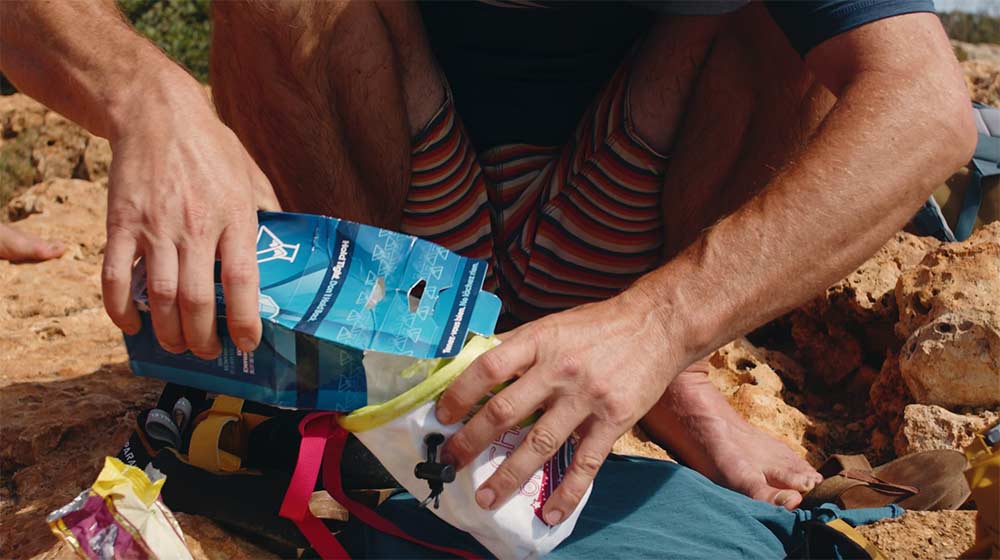
Another approach for crafty people is to make a magnesium bag from Ikea bag material.
Magnesium
For deep water soloing you should bring magnesium, lots of magnesium. Best as a powder or in liquid form. This has less to do with the fact that you sweat more under the Mediterranean sun. Since you want to have enough magnesium with you for the climb, but at the same time destroy the entire contents of the bag as soon as you fly off, the consumption is significantly higher than with sport climbing or bouldering.
Tip for purists who don't want to use the magnesium bag: Liquid magnesium can also be applied as a small bead to both forearms and use this supply on the go. If you rub your fingers over the dried surface, the magnesium comes off and dries the fingertips.
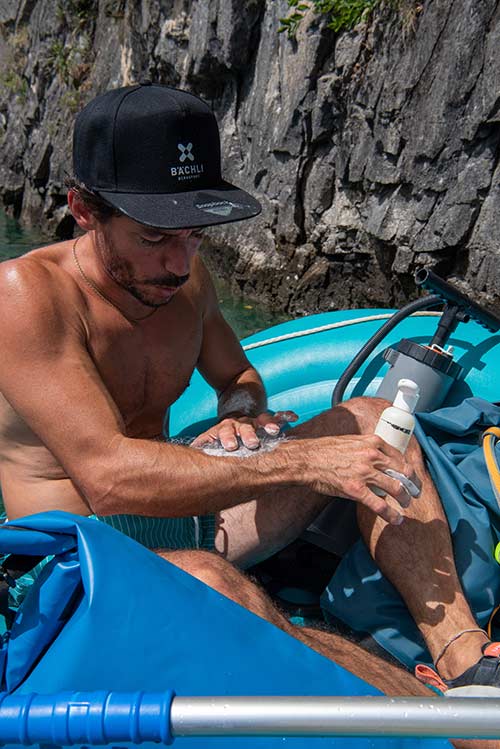
Water bag
A dry bag or other waterproof bag is almost indispensable for bringing your personal climbing equipment to the base of the wall.
Since you have to climb down in many places, a bag with two carrying straps is a little more comfortable. A dry bag can also be used optimally as a swimming buoy for rescue.
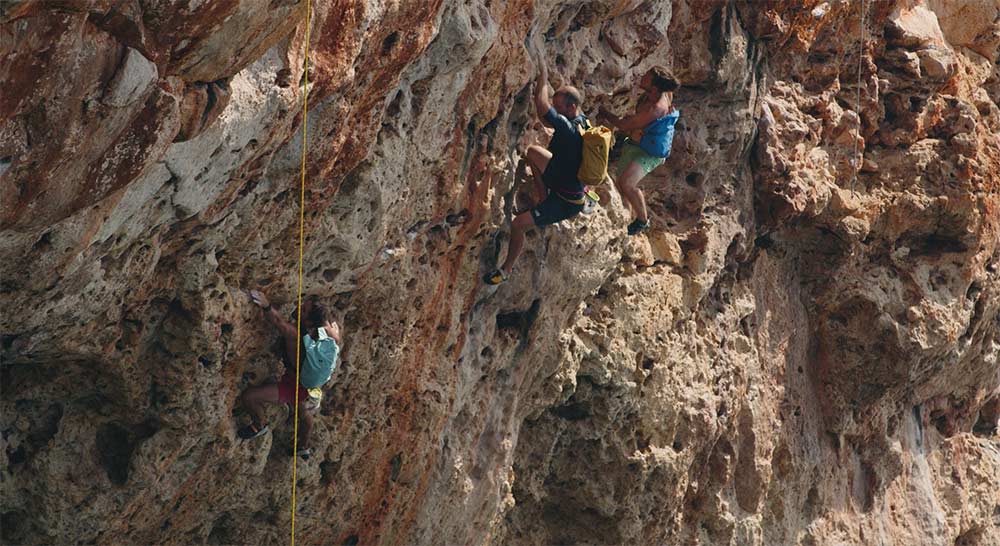
stepladder
A stepladder, or at least an old rope with knotted loops, is more than just nice to have in many places. Many established DWS spots already have material that makes it easier to get out of the water. However, due to the weather, their quality can vary greatly.
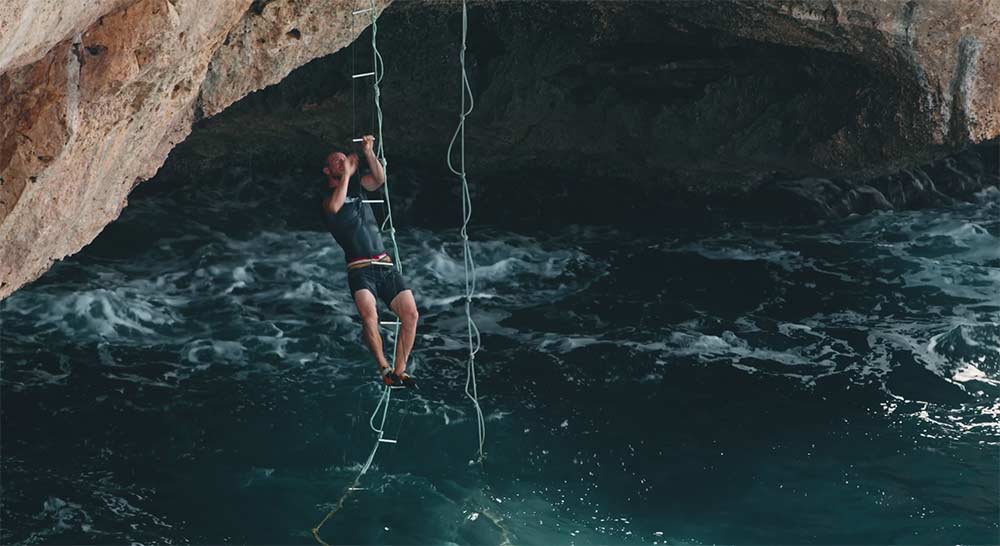
swimming goggles
Trust is good, control is better. True to this motto, it is also worth taking a closer look at the landing zone at well-known spots. If you are exploring new areas on your own, diving must be your top priority before climbing. And apart from that, it's just nice to chase the fish every now and then.
From above it is sometimes difficult to estimate how deep the water is or how high a rock rises to the surface.
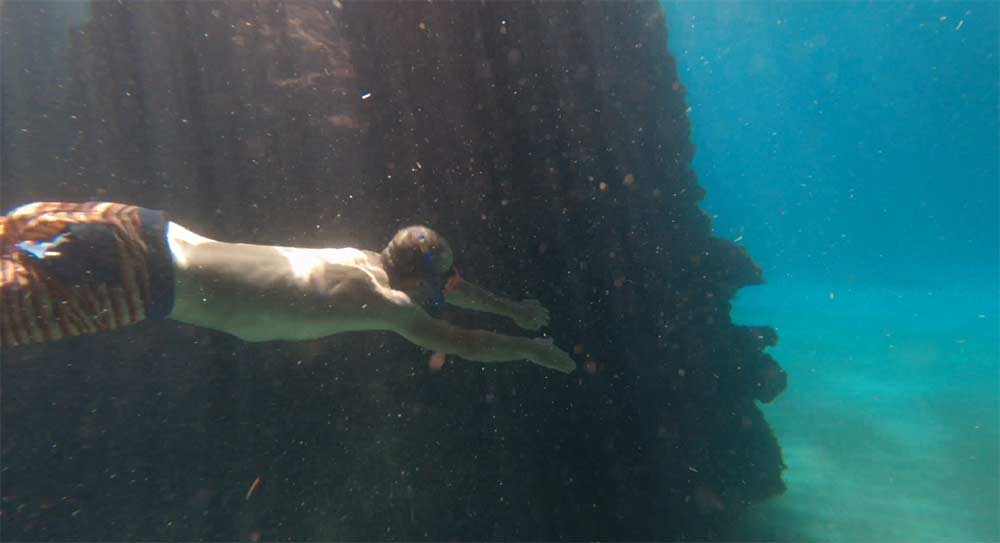
Carbine
One or two carabiners don't hurt just to make sure you're comfortable when starting the route. You often start from a cave into the overhangs and hang your water bag accordingly. Carabiners are also very helpful for hanging up climbing finches to dry.
Slings, rope protection and rope
If you plan to check out a more difficult route from above, you should pack additional climbing material. In some areas, instead of climbing down, you can also set up a rappelling stand and get to the “base of the wall” comfortably.
The rough rock on the coast offers optimal anchor points at hourglasses almost everywhere. In addition to robust slings, rope protection is an absolute must.
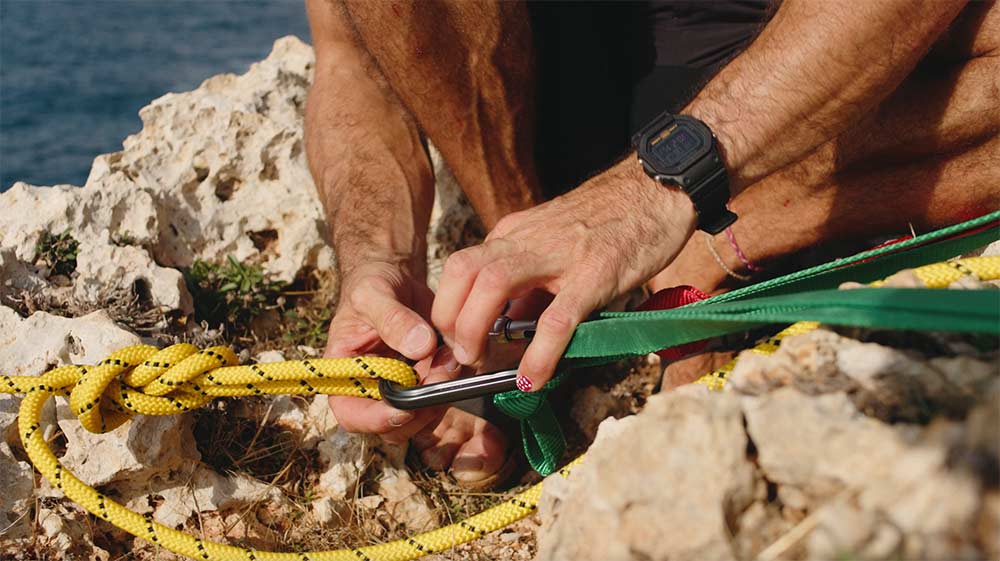
What safety precautions should be taken?
Before you start a route, you should make sure that you get out of the water and install a rope ladder or a piece of rope at the exit.
In strong waves, the exit should not be underestimated. This is usually only possible at the moment when the wave is surging. At the same time, you have to make sure that you don't get hit by the razor-sharp rock.
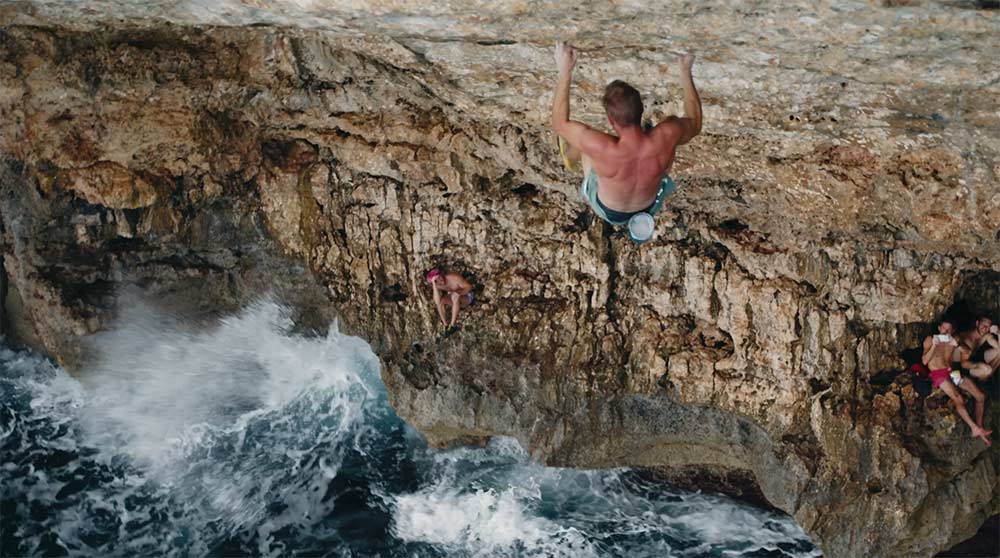
Depending on the tide, the water level can also vary greatly. Mallorca is less affected by this, the situation is different in England or Vietnam, for example. In general, the landing and the water depth should be inspected before climbing. If in doubt, you should take out your diving goggles and form your own opinion.
Depending on the current, jellyfish can be a problem in the Mediterranean. That's why it's important to check the water carefully and, if necessary, ask locals for advice.
Deep water soloing is no Individual sport and not always completely safe. That's why there should be at least two people, and even better a group of 3 or more people. One climbs, the other watches attentively.
Deep water soloing is no Individual sport and not always completely safe.
This way you can quickly help each other if a fall goes badly or someone can't get out of the water due to exhaustion. In order not to waste unnecessary time in an emergency, it is worth always having a swimming aid (e.g. dry bag with a leash) ready.
A completely different kind of safety precaution is not to leave any valuables in the rental car.
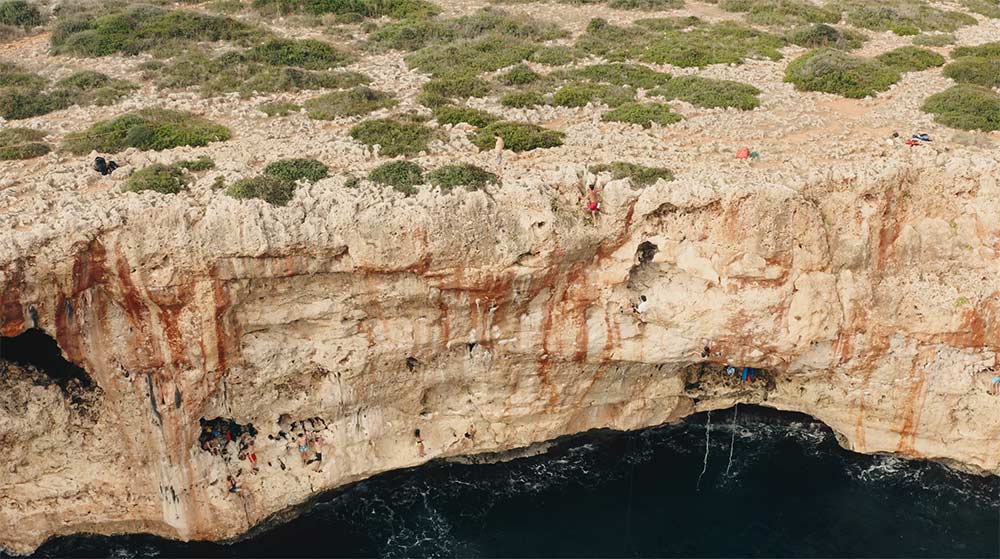
How do I reach the start of the routes?
In most sectors there is a so-called downclimb. It is usually the easiest route on the edge of a sector, which is climbed down to reach the entrances to the more difficult lines.
People often cross into the wall and then start climbing straight away. Of course, it is also possible to jump in and start directly from the water. However, this method has the obvious disadvantage that you and all the equipment are wet.
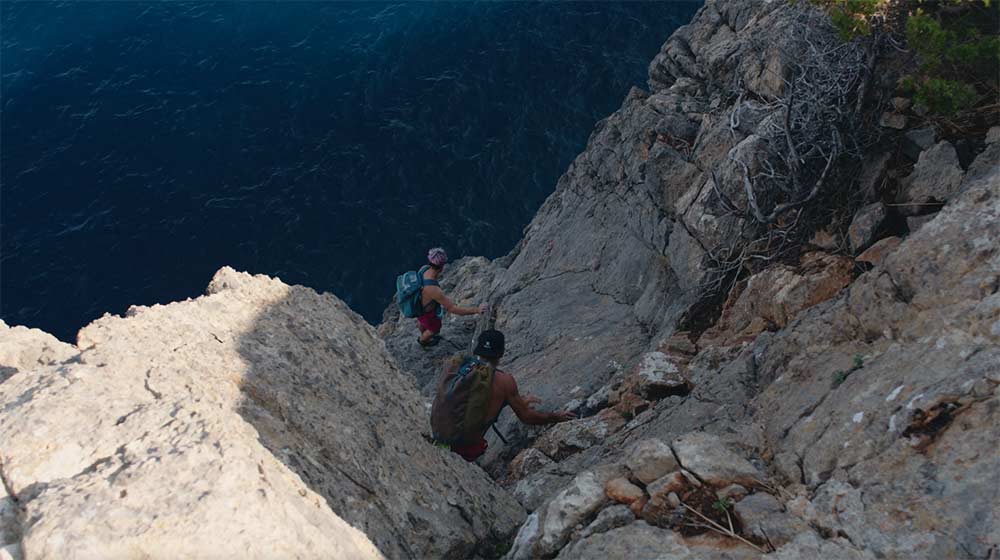
Probably the most comfortable way to reach the start of a route is by boat. When there are waves, this can be a tricky affair that requires an experienced boat operator. And it is withheld from those who can afford the necessary change to cover the rental costs.
What makes Mallorca the ultimate deep water soloing spot?
Mallorca, the largest island in the Balearic group, has numerous cliffs on its coast that drop steeply into the sea. Especially in the southeast, but also in the west and northwest, the variety of weathered, sintered and often heavily overhanging walls is huge.
Added to this is the subtropical climate of the Mediterranean island, which often ensures pleasant water temperatures, the delicious local food and the relaxed islanders.
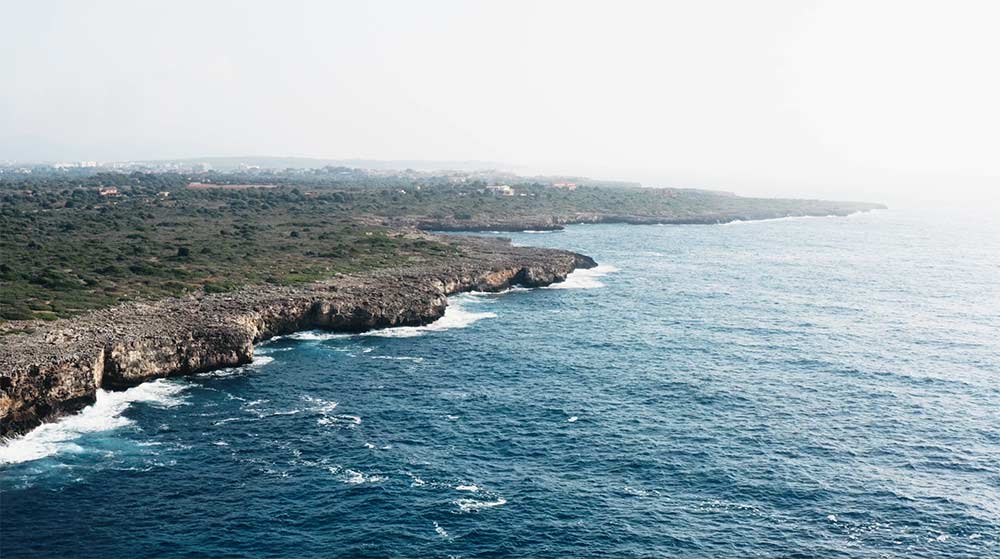
Where are the different climbing spots?
The highest density of first-class DWS spots can be found on the southeast coast of Mallorca. Between Santanyí and Porto Cristo alone – a stretch of coast a good 30 kilometers long – there are nine areas of very different character.
Between Santanyí and Porto Cristo alone there are nine areas of very different character.
You can also climb around Port de Sóller in the northwest of the island or south of the capital Palma. The island's full potential is still far from being tapped. And so it's hardly surprising that new cliffs, caves and climbable features are constantly being developed.
Which areas are suitable for entry into DWS?
Cala Varques is the perfect place for your first steps in this discipline of climbing. On the one hand, the rocks in the four sectors of Cova, Metrosexual, Snatch and Tarantino are not excessively high, and on the other hand, there are several beautiful routes of moderate difficulty.
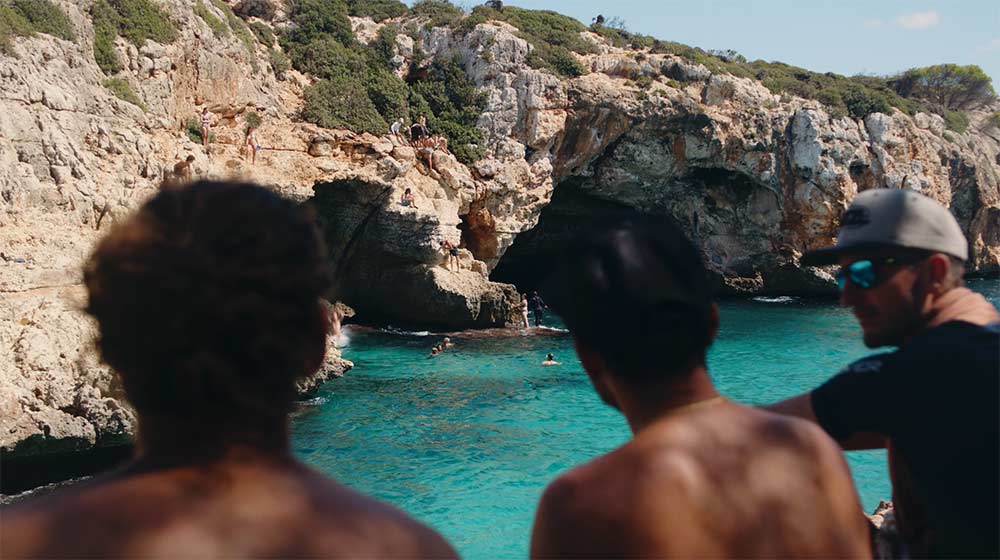
The entrances to the routes in Cala Varques are usually easy and safe to reach. In addition, the turquoise and often calm water has a calming effect on the psyche while climbing. This is in comparison to other places where the waves crash violently against the base of the wall.
Cala Varques is basically the plaisir area for deep water soloing.
The icing on the cake at this DWS spot is the almost kitschy sandy beach and the crystal clear water, which is ideal for diving and snorkeling. Since access from the main road has been closed, the journey has been extended to a good half hour.
Where do hard movers find difficult DWS lines?
The way nature has shaped the impressive cliffs on the coast of Mallorca plays into the hands of climbers in the upper levels of difficulty. The climbing is often very overhanging and therefore quickly becomes difficult.
In the upper seventh and eighth French degrees there are enough lines in almost all areas. If you are looking for even harder routes, you should head for Port de Sóller. Find yourself there Alasha (9a +) and Big Fish (8c+/9a) two of the most difficult lines on the island.
Plays in the same order of magnitude Es Pontas (9a+), the iconic line with which Chris Sharma made not only Deep Water Soloing but also Mallorca world famous as a DWS spot in 2006.
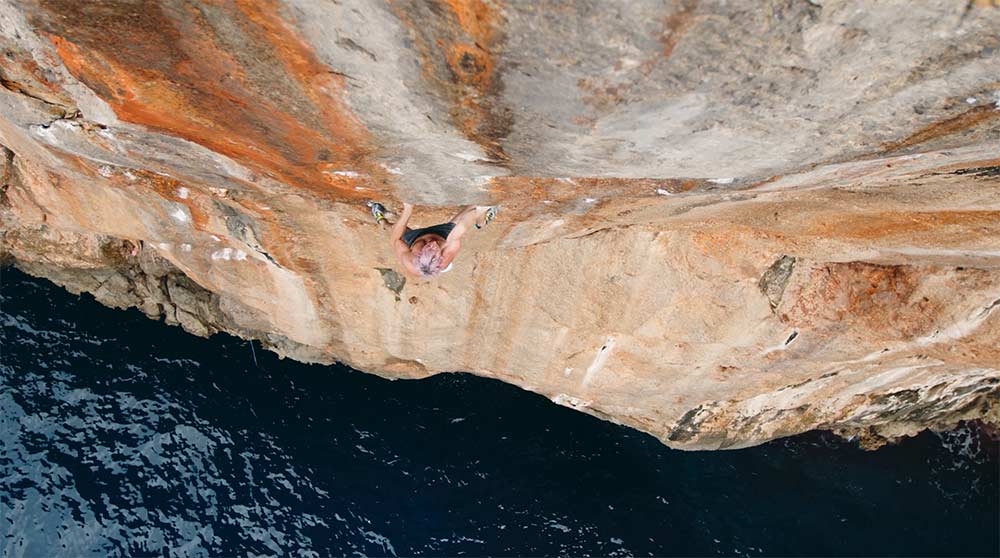
What are the four best spots on the island?
1 Cala Varques
Although it is known as a popular area for the first attempts at DWS and is correspondingly well frequented, Cala Varques is still worth a visit, especially if you want to slowly get used to deep water solo climbing. The idyllic beach, turquoise water and easily accessible routes compensate for the busy local population. The beach and the climbing area can be reached in around 30 minutes.
Top routes: Our route recommendations are Big XXL (6b), Genoveses (6b) and Transversal (7a) in the Sa Cova sector. In the Metrosexual sector there are the routes of the same name rated 7a, Bisexual (6b) or Bandito (7c). Easier but still worthwhile routes are Fortuna (5c) and Hércules (6a+) in the Snatch sector.
2 Porto Colom
Back in the summer of 1998, climbing guide author Miquel Riera jumped into the water from the rock bar near the lighthouse to take a look at the area. However, it took six years for him to climb his first lines together with Toni Lamprecht and Chris Sharma. Today Porto Colom is undisputedly one of the coolest areas of Mallorca. A comfortable area for watching and drying, easy access to the routes via a cross passage make Porto Colom a top spot for deep water solo climbing.
Top routes: Our route recommendations near Porto Colom are Prince of Transilvania (7a) and I live in a cave (6b). The area is accessible via easy walking and scrambling terrain.
3 Cova del Diablo
The impressive cliff at Porto Cristo, up to 18 meters high, offers great climbing and numerous exposed lines of holes and ledges in the seventh and eighth French degrees. From the caves and niches at the base of the wall you can enjoy an incomparable panorama of the sea. For many, Cova del Diablo is considered one of the best DWS spots on the island.
Top routes: Route recommendations in the ocher wall are Afroman (7b), Ejector Seat (7c) or of course the spectacular Loskot and two smoking barrels (8a). The Lobster route (6c) is recommended for the sixth French degree. To the left and right of the main wall there are other routes in the sixth French degree. You can access the routes via the “downclimbs” or you can set up a fixed rope at the numerous hourglasses so you can abseil down.
4 Cala Mitjana
The area is located northeast of the tourist village of Cala d'Or and is easy to find thanks to the distinctive sailing masts installed on the coast. The descent to the routes on the left is easy, the quality of the routes is very good. Directly nearby is the Rich Bitch sector, which, with a height of just seven meters, is easy on the nerves. There are other worthwhile lines on the Terry Wall. Everyone gets their money’s worth at Cala Mitjana.
Top routes: We recommend the two routes Mitjana Party and Mitjana Party left (7a and 6c) in the left area, which lead past a striking hole in which you can relax again shortly before getting out. In the Rich Bitch sector, the route of the same name (7a) is highly recommended. But Geek (6a) and Bandy (5) are also nice lines in easy terrain.
If you would like to visit the place where Deep Water Solo climbing history was written, you should plan a visit to the impressive rock arch in Cala Santanyí.
In addition to the legendary Es Pontas route by Chris Sharma, there is also a line with a more moderate level of difficulty, the Toni route (7b). There are even easier tours in area 6a/6b southwest of Es Pontas in the Ballam area.
These are the 10 most beautiful deep water solo routes on Mallorca in the 6th and 7th French degrees
- Metrosexual (7a), Metrosexual sector, Cala Varques
- Bandito (7c), Metrosexual sector, Cala Varques
- Afroman (7b), Lobster Area sector, Cova del Diablo, Porto Cristo
- Ejector seat (7c), Lobster Area sector, Cova del Diablo, Porto Cristo
- Prince of Transylvania (7a), Porto Colom
- Me llamo Chris (6c), Porto Colom
- Rich Bitch (7a), Rich Bitch sector, Cala Mitjana
- Mitjana Party (7a+), Wall of Illuminations sector, Cala Mitjana
- Illuminations (6b+), Wall of Illuminations sector, Cala Mitjana
- New Forms (6b+), Wall of Illuminations sector, Cala Mitjana
When it came to the difficulty levels, we based the majority of the assessment on the climbing guide Psicobloc by Miquel Riera.
Topo/Climbing Guide Deep Water Solo Climbing in Mallorca
In order to orient yourself on the island and prepare for the trip, there are two climbing guides in classic book form: Psicobloc Mallorca by Miquel Riera and Spain Mallorca from Rockfax or then the app from 27 Crags.
That might interest you
- The most beautiful deep water soloing spots in Switzerland
- Chris Sharma on Deep Water Soloing ExpeditionFirst a bad departure, then a climb: Matty Hong repeats Big Fish (8c+/9a)
Do you like our climbing magazine? When launching the climbing magazine Lacrux, we decided not to introduce a paywall because we want to provide as many like-minded people as possible with news from the climbing scene.
In order to be more independent of advertising revenue in the future and to provide you with even more and better content, we need your support.
Therefore: Help and support our magazine with a small contribution. Naturally you benefit multiple times. How? You will find out here.

